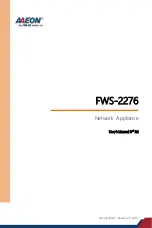
The Need for Guarantees
A problem can occur however if prioritized traffic is a continuous stream such as real-time audio,
resulting in continuous use of all available bandwidth and resulting in unacceptably long queuing
times for other services such as surfing, DNS or FTP. A means is required to ensure that lower
priority traffic gets some portion of bandwidth and this is done with Bandwidth Guarantees.
Using Precedences as Guarantees
Specifying a limit for a precedence also guarantees that there is a minimum amount of bandwidth
available for that precedence. Traffic flowing through a pipe will get the guarantee specified for the
precedence it has, at the expense of traffic with lower precedences.
To change the prioritized SSH and Telnet traffic from the previous example to a 96 kbps guarantee,
the precedence 2 limit for the std-in pipe is set to be 96 kbps.
This does not mean that inbound SSH and Telnet traffic is limited to 96 kbps. Limits in precedences
above the best effort precedence will only limit how much of the traffic gets to pass in that specific
precedence.
If more than 96 kbps of precedence 2 traffic arrives, any excess traffic will be moved down to the
best effort precedence. All traffic at the best effort precedence is then forwarded on a first-come,
first-forwarded basis.
Note: A limit on the lowest precedence has no meaning
Setting a maximum limit for the lowest (best effort) precedence or any lower
precedences has no meaning and will be ignored by NetDefendOS.
Differentiated Guarantees
A problem arises if the aim is to give a specific 32 kbps guarantee to Telnet traffic, and a specific 64
kbps guarantee to SSH traffic. A 32 kbps limit could be set for precedence 2, a 64 kbps limit set for
precedence 4 and then pass the different types of traffic through each precedence. However, there
are two obvious problems with this approach:
•
Which traffic is more important? This question does not pose much of a problem here, but it
becomes more pronounced as the traffic shaping scenario becomes more complex.
•
The number of precedences is limited. This may not be sufficient in all cases, even without the
"which traffic is more important?" problem.
The solution is to create two new pipes: one for telnet traffic, and one for SSH traffic, much like the
"surf" pipe that was created earlier.
First, remove the 96 kbps limit from the std-in pipe, then create two new pipes: ssh-in and
telnet-in. Set the default precedence for both pipes to 2, and the precedence 2 limits to 32 and 64
kbps, respectively.
Then, split the previously defined rule covering ports 22 through 23 into two rules, covering 22 and
23, respectively:
Keep the forward chain of both rules as std-out only. Again, to simplify this example, we
concentrate only on inbound traffic, which is the direction that is the most likely to be the first one
to fill up in client-oriented setups.
Set the return chain of the port 22 rule to ssh-in followed by std-in.
Set the return chain of the port 23 rule to telnet-in followed by std-in.
10.1.6. Precedences
Chapter 10. Traffic Management
461
Summary of Contents for NetDefend DFL-260E
Page 27: ...1 3 NetDefendOS State Engine Packet Flow Chapter 1 NetDefendOS Overview 27...
Page 79: ...2 7 3 Restore to Factory Defaults Chapter 2 Management and Maintenance 79...
Page 146: ...3 9 DNS Chapter 3 Fundamentals 146...
Page 227: ...4 7 5 Advanced Settings for Transparent Mode Chapter 4 Routing 227...
Page 241: ...5 4 IP Pools Chapter 5 DHCP Services 241...
Page 339: ...6 7 Blacklisting Hosts and Networks Chapter 6 Security Mechanisms 339...
Page 360: ...7 4 7 SAT and FwdFast Rules Chapter 7 Address Translation 360...
Page 382: ...8 3 Customizing HTML Pages Chapter 8 User Authentication 382...
Page 386: ...The TLS ALG 9 1 5 The TLS Alternative for VPN Chapter 9 VPN 386...
Page 439: ...Figure 9 3 PPTP Client Usage 9 5 4 PPTP L2TP Clients Chapter 9 VPN 439...
Page 450: ...9 7 6 Specific Symptoms Chapter 9 VPN 450...
Page 488: ...10 4 6 Setting Up SLB_SAT Rules Chapter 10 Traffic Management 488...
Page 503: ...11 6 HA Advanced Settings Chapter 11 High Availability 503...
Page 510: ...12 3 5 Limitations Chapter 12 ZoneDefense 510...
Page 533: ...13 9 Miscellaneous Settings Chapter 13 Advanced Settings 533...









































